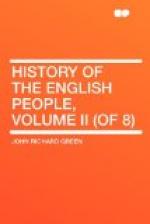[Sidenote: Bannockburn]
The king’s burst of grief was as fruitless as his threats of vengeance; a feigned submission of the conquerors completed the royal humiliation, and the barons knelt before Edward in Westminster Hall to receive a pardon which seemed the deathblow of the royal power. But if Edward was powerless to conquer the baronage he could still by evading the observance of the Ordinances throw the whole realm into confusion. The two years that follow Gaveston’s death are among the darkest in our history. A terrible succession of famines intensified the suffering which sprang from the utter absence of all rule as dissension raged between the barons and the king. At last a common peril drew both parties together. The Scots had profited by the English troubles, and Bruce’s “harrying of Buchan” after his defeat of its Earl, who had joined the English army, fairly turned the tide of success in his favour. Edinburgh, Roxburgh, Perth, and most of the Scotch fortresses fell one by one into King Robert’s hands. The clergy met in council and owned him as their lawful lord. Gradually the Scotch barons who still held to the English cause were coerced into submission, and Bruce found himself strong enough to invest Stirling, the last and the most important of the Scotch fortresses which held out for Edward. Stirling was in fact the key of Scotland, and its danger roused England out of its civil strife to an effort for the recovery of its prey. At the close of 1313 Edward recognized the Ordinances, and a liberal grant from the Parliament enabled him to take the field. Lancaster indeed still held aloof on the ground that the king had not sought the assent of Parliament




